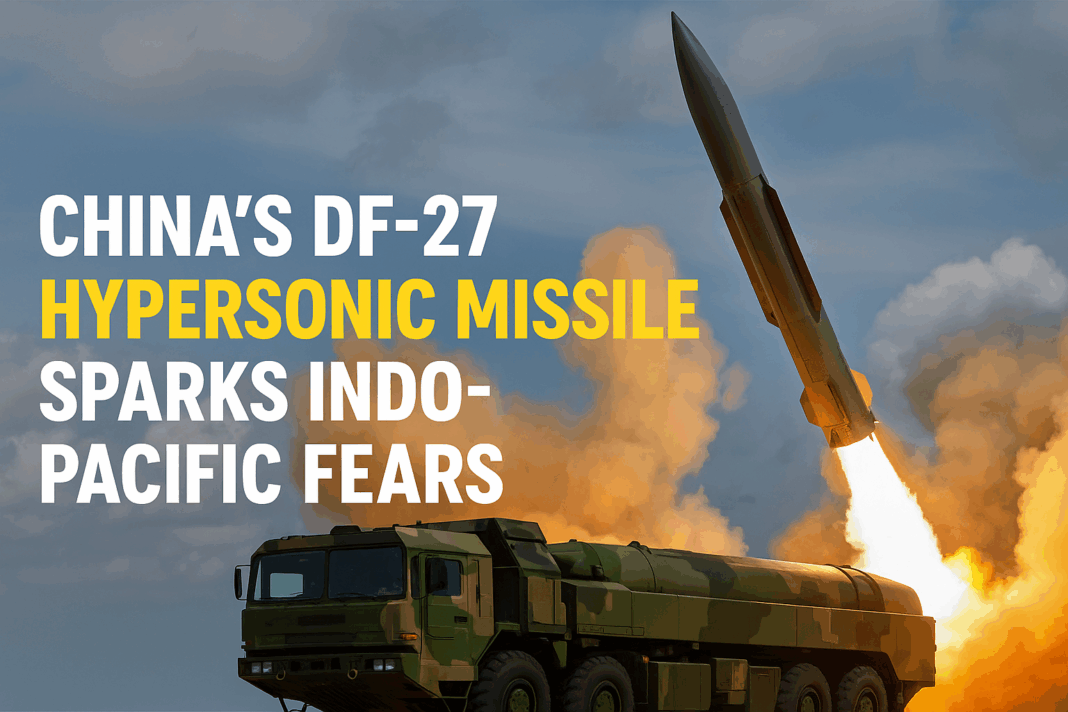China’s DF-27 missile has become one of the most talked-about military threats in the Indo-Pacific region. First acknowledged in a U.S. military report in 2021, the DF-27 is believed to be a long-range missile with a powerful twist—it may be hypersonic.
A Missile Wrapped in Secrecy
Despite very few official details, its reported range of 5,000 to 8,000 kilometers places major U.S. allies like Japan, South Korea, and the U.S. territory of Guam within its reach.
This missile isn’t launched from fixed locations. Instead, it’s likely designed to be mobile, carried on trucks or other vehicles that can move around China’s vast territory. That makes it even harder to detect before launch. The missile’s ability to strike from deep within China while targeting faraway areas is what makes it a serious concern for the U.S. military.
Although some reports have labeled the DF-27 as an Intermediate-Range Ballistic Missile (IRBM), others suggest it may fall into the Intercontinental Ballistic Missile (ICBM) class. Its wide range and possible advanced technology make it a major factor in military planning.
China’s Veiled Warning to US; WZ-9 Drone Could Detect F-35 and B-21
Speed That Overwhelms Defenses
What truly sets the DF-27 apart is its potential to fly at hypersonic speeds—meaning more than five times the speed of sound. Missiles that move this fast can be extremely difficult to intercept. They leave very little time for defenses to react. While older missiles fly in predictable paths, hypersonic ones can change direction mid-flight, dodging interception attempts.
This capability would make the DF-27 especially dangerous to places like Guam and Japan. The Italian-German collaboration intends to use this design to build submarines for the Philippines as well. Both are well within the range of the DF-27. The missile could strike in a matter of minutes at hypersonic speeds, giving military leaders no time to respond appropriately.
The DF-27’s guidance system is one of its most significant unknowns. If it can correct its path mid-air or aim precisely at targets, then existing air defense systems may not be able to stop it. That kind of technology would allow the missile to hit exact spots—such as military bases—rather than just general areas.
Because of this, the Pentagon is pushing forward with advanced tracking systems. In low and medium Earth orbits, it is constructing satellite networks. These satellites are meant to watch the skies at all times, connecting with each other to follow missiles like the DF-27 the moment they are launched.
China’s BeiDou Network Reportedly Tracks F-35 Using Revolutionary Heat Signature Detection
A Wide-Reaching Threat
The DF-27’s reported reach of up to 8,000 kilometers allows it to hit a wide range of targets across the Pacific. That includes not just nearby nations, but also key U.S. bases. Guam is already within range, but even Hawaii—about 9,558 kilometers from China—is not far out of reach if the missile’s range increases in future versions.
While other Chinese missiles like the CSS-4 can travel even farther, up to 13,000 kilometers, the DF-27’s combination of speed and range is what makes it unique. Unlike many ICBMs, which fly in a high arc, hypersonic missiles may glide at lower altitudes and shift course along the way, making them harder to detect and destroy.
Even without full knowledge of the missile’s technical details, its range alone puts U.S. and allied forces on high alert. With mobile launchers, hypersonic speed, and potential precision guidance, the DF-27 creates a major challenge in defending U.S. interests in the Pacific.
Falasteen-2 Hypersonic Missile Hits Israel’s Top-Secret Sdot Micha Base in Major Escalation
This growing threat has pushed the U.S. to focus more on early warning systems and advanced technology to track and potentially stop these kinds of weapons. While much remains uncertain about the DF-27, one fact is clear—it is already changing the way countries think about missile defense.

